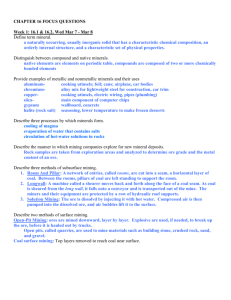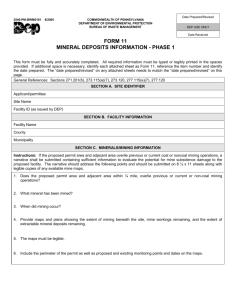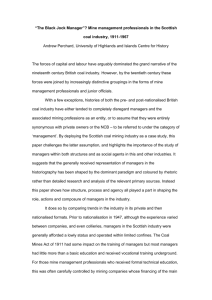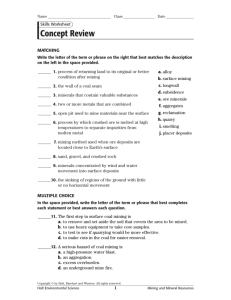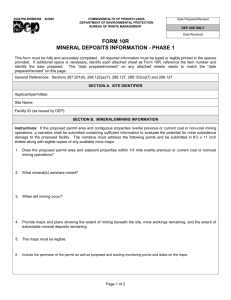Energy - Lake Stevens High School
advertisement
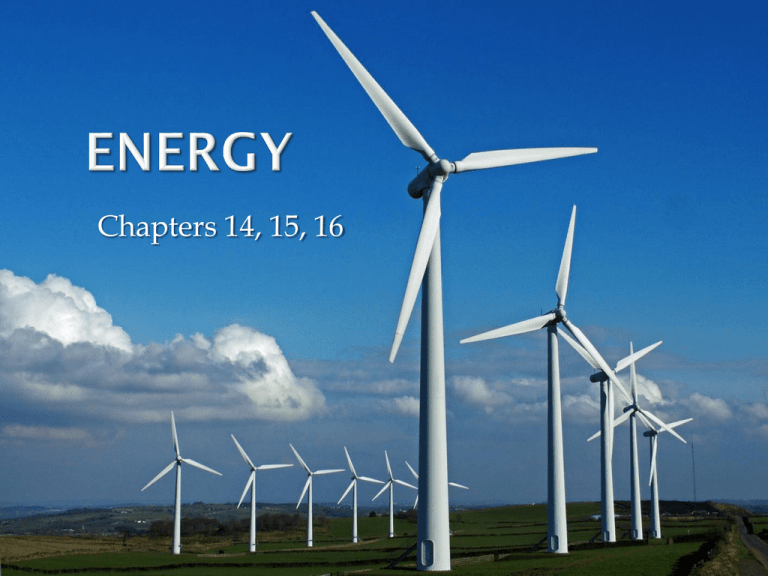
Chapters 14, 15, 16 Net energy: usable amount of high quality energy available from a given energy source, minus the cost from extraction and processing The more energy used in the extracting and refining process, the less energy will be available (decreased net energy) Improved by decreasing waste Fuel efficiency Building insulation Efficient coal/nuclear plants Takes high quality energy to get high quality energy As energy is used it is wasted or degraded Laws of thermodynamics (Chapter 2) Nonrenewable Sources Exist in fixed quantities Most commercial energy comes from the burning of fossil fuels Oil, Natural Gas, Coal (fossilized organisms) Nuclear Renewable Sources Replenished through natural processes Solar, Hydropower, Wind, Biomass, Geothermal, Hydrogen Low net energy sources subsidized by governments Nonrenewable vs. Renewable 5 times greater than the rest of the world Developed countries used 70% of the worlds energy, and have 20% of the worlds population Mineral naturally occurring, inorganic, solid element or compound with a definite chemical composition and a regular internal crystal structure We can extract and process at a reasonable cost Gold, sulfur, diamond, silver; salt, mica, quartz Rock solid, cohesive, aggregate of one or more minerals Each rock type has a characteristic mixture of minerals Limestone, quartzite Metallic Iron (steel) , copper (wiring), gold (jewelry), and aluminum (packaging and cans) Nonmetallic Phosphate Salts (fertilizer), limestone (concrete), and sand (glass, bricks, concrete) Ore Rock containing one or more metallic mineral High and low-grade ore Copper and gold mined together Types of Mining Surface Mining Shallow deposits; remove all soil, vegetation and rock to expose mineral Used in 90% of US mineral extraction and 60% of coal mining Ex. Open pit mining, strip mining, contour strip mining, mountaintop removal Subsurface Mining Underground deposits removed through tunnels and shafts Deep coal and metal ore deposits Machine digs holes to remove ore, sand, gravel and stone Iron, copper, gold, limestone and marble Open-Pit Copper Mine, UT Diamond Mine, Russia Diamond Mine, Canada Use on flat terrain Strip away overburden, dig out mineral deposit Trench filled back with overburden and new trench dug parallel to previous Leaves behind wavy highly erodible hills Used on hilly, mountainous terrain Cut terraces into sides of hill Overburden dumped onto terrace below Wall of dirt in front of highly erodible rock and soil Use explosives, massive shovels to remove top of mountain to expose coal seams Waste dirt pushed down into streams and valleys Causes considerable environment damage More than 500 mountaintops have been removed in West Virginia and other Appalachian States Mountaintop Removal, WV Mountaintop Removal Mountaintop Removal Mountaintop Removal, West Virginia Room-and-Pillar Machinery gouges out coal and load onto cart Pillars of coal left to support mine roof Longwall Steel props support mining roof Coal sheared off onto mining belt As supports moved, roof behind allowed to fall Result in collapse of land above Land surface disrupted and scarred Left to susceptible to weathering and erosion Vegetation re-grow slowly (no topsoil) Primary succession Acidic mine drainage in streams and groundwater (sulfuric acid and mercury) From processing of metals Toxic chemicals emitted into atmosphere By blasting rock..more toxic emissions than any other industry Lower grade ores take more money Human Health hazards Black lung Harmful effects often exceed value of minerals extracted Costly cleanup efforts for years after mining stops Overburden—soil and rock removed from mineral deposit Spoils—piles of waste material Tailings—piles of waste from extracting metal from ore (smelting) Gangue-waste material mixed with mineral in ore Subsidence- collapse of land above subsurface mines Most mineral resources are supplied by the US, Canada, Russia, South Africa and Australia 90% of minerals needed by US are imported Economic depletion: not cost effective to mine, process, and transport mineral Metal Global Reserves Remaining (years) US Reserves Remaining (years) Iron 120 40 Aluminum 330 2 Copper 65 40 Lead 20 40 Zinc 30 25 Gold 30 20 Nickel 75 0 Cobalt 50 0 Manganese 70 0 Chromium 75 0 Type of Mining Operation Effects on Air Effects on Water Effects on Effects on Soil Biodiversity Effects on Humans Surface Mining Significant dust from earth moving equipment Contamination of water percolates through tailings Soil removed from site, replaced if reclaimed Habitat alteration and destruction Minimal in mining process, but air quality and water quality adversely affected Subsurface Mining Minimal dust, but emissions from fossil fuels from equipment Acid mine drainage plus contamination that percolates through tailings Subsidence of land above Road construction fragments habitat Occupational hazards in mine; chronic respiratory diseases 1977 Surface Mining and Reclamation Act (SMRCA) Requires mining companies to restore surface-mined land so that it can be used for the same purpose as before Taxes on mining companies to restore sites pre-1977 Funding weakened due to lobbying, limits enforcement Reclamation includes maintaining water and air quality, minimizing flooding, erosion and damage to wildlife and aquatic habitats caused by surface mining. Why do you think reclamation is such a huge issue for mining companies? Clean Air and Water Acts 1970 Limits pollutants emitted into air and water and requires companies to comply with requirements Superfund Act (Comprehensive Environmental Response, Compensation, and Liability Act— CERCLA) Site contaminated with hazardous pollutants must be cleaned up following regulations Implemented by the EPA Used for abandoned mines prior to 1970s Finding substitutes for metals with silicon, plastics, ceramics or nanotechnology Decrease Use and Waste Fiber optic cables (replace copper/aluminum wires) Carbon and glass fiber composites (cars/airplanes) Instead of increasing supplies Recycle/Reuse Less polluting, less energy use than mining for new metals Bristol Bay, Alaska Environmental Concerns Harm to fisheries (pristine salmon run) Harm to ecosystem Groundwater contamination Earthquake hazard? Economic Benefits Site is located in a remote and uninhabited area Jobs for 25+ years in area with low economic opportunities Reduce reliance on foreign sources of minerals Recent Developments January 2014 EPA publishes assessment on impacts of proposed mine Allows Clean Water Act to be envoked Large scale mining would pose risks to salmon and native Alaskan people who depend on them 24-94 miles of stream potentially affected 1300-1500 acres of wetlands, ponds and lakes destroyed Pollution and chemical leachate from tailings ponds will affect streams Failures in wastewater treatment, transportation, pipelines or tailings dams would have catastrophic effects on surrounding ecosystems and fisheries (Peer reviewed and approved by 12 industry expert scientists) Coal is extracted by mining. Either subsurface or surface mines (strip mining or mountaintop removal) Once mined the coal is washed to remove excess materials The energy comes from burning of the mined coal Coal is burned to produce heat Coal is ground to powder Steam spins turbine to produce electricity Heat from coal warms water to produce steam The burning of coal releases pollutants into the atmosphere. Carbon dioxide (global warming) Sulfur dioxide (acid rain) Nitrogen oxides (smog) Particulates (respiratory diseases and hazy skies) Heavy metals (mecury, lead, arsenic) Coal is a reliable source of energy! One coal plant can power up to 800,000 homes! US Coal Reserves are expected to last for 250 years! Coal is also safe to transport. Coal isn’t radioactive and it won’t explode. Coal supplies half the energy in the US! Coal is cheap! Most power plants use coal because its cost-effective and produces cheap electricity for families It is the least expensive way to produce electricity The average cost is $.07 per kWh, this would be about $750 per year for the average family (CHEAP!) Coal plants have taken steps to reduce environmental impact…so the low cost is justified “clean coal” Environmental Cost of Coal Air pollution minimized by “scrubbers” Technology that is working on removing excess greenhouse gases from emissions from burning coal. Yes it is the dirtiest of the fossil fuels…but we’re working on it. Mining impacts… Reclamation of abandoned mines Subsurface mine less impact on land surface Subject to Clean Air and Water Act regulations…as well as CERCLA and SMRCA DISADVANTAGES ADVANTAGES Cheap to produce Abundant source Easy to transport Non-radioactive Non-explosive One plant produces a lot of energy Large environmental impact Mining coal destructive to environment Environmental impacts from mining as well as burning Human health hazards from emissions and mining Non-renewable resource Major Spills in history include… Gulf War (1991)—240-300 million gallons Deepwater Horizon Oil Spill (2010)—210 million gallons Ixtoc 1 Spill (1979)—140 million gallons Exxon-Valdez (1989)—11 million gallons Deepwater Horizon, April 2010 Mechanical Method Used to contain and then mechanically remove the spilled oil Usually primary line of defense Booms, barriers, skimmers, sorbent materials Physical Removal Manually cleaning up shorelines or habitats affected Shovels, bulldozing, pressure washing, wiping down plants and animals Chemical or Biological Methods Agents used to disperse oil before it reaches shorelines Dispersing and gelling agents Can you remove all of the oil after a spill? Using the provided materials…see if you can clean up an oil spill in water.

